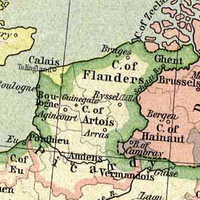Artois
This articleneeds additional citations forverification.(May 2020) |
| Government of Artois Gouvernment d'Artois | |||||||||
|---|---|---|---|---|---|---|---|---|---|
| 1764–1790 | |||||||||
|
Flag | |||||||||
 Location of Artois in France (1789 borders) | |||||||||
| Capital | Arras | ||||||||
| Demonym | Artesians(French:Artésiens) | ||||||||
| Government | |||||||||
| • Type | Province | ||||||||
| King of France | |||||||||
• 1764–1774 | Louis XV | ||||||||
• 1774–1790 | Louis XVI | ||||||||
| Governor of Artois | |||||||||
• 1764–1787 | François Gaston de Lévis | ||||||||
• 1788–1789 | Adrien-Louis de Bonnières | ||||||||
| Historical era | Early Modern | ||||||||
• County created | 1764 | ||||||||
• Disestablished | 1790 | ||||||||
| |||||||||
| Today part of | France | ||||||||
Artois(/ɑːrˈtwɑː/ar-TWAH,French:[aʁtwɑ];Dutch:Artesië;Picard:Artoé;English adjective:Artesian) is a region ofnorthern France.Its territory covers an area of about 4,000 km2and it has a population of about one million. Its principal cities includeArras(Dutch:Atrecht),Saint-Omer,Lens,andBéthune.It is theeponymfor the termArtesian.
Location
[edit]Artois occupies the interior of thePas-de-Calaisdépartement,[1]the western part of which constitutes the formerBoulonnais.Artois roughly corresponds to thearrondissementsofArras,Béthune,Saint Omer,andLens,and the eastern part of thearrondissement of Montreuil.It occupies the western end of thecoalfieldwhich stretches eastward through the neighbouringNorddépartementand across centralBelgium.
History
[edit]
Originally a feudal county itself, Artois was annexed by thecounty of Flanders.It came to France in 1180 as a dowry of a Flemish princess,Isabelle of Hainaut,and was again made aseparate countyin 1237 forRobert,a grandson of Isabelle. Through inheritance, Artois came under the rule of the dukes ofBurgundyin 1384. At the death of the fourth duke,Charles the Bold,Artois was inherited by theHabsburgsand passed to the dynasty's Spanish line. After the religious revolts of 1566 in the Netherlands, Artois briefly entered theDutch Revoltin 1576, participating in thePacification of Ghentuntil it formed theUnion of Atrechtin 1579.
After the Union of Atrecht, Artois andHainaut(Dutch:Henegouwen) reached a separate agreement withPhilip II.Artois remained with the Spanish Netherlands until it was conquered by France during theFranco-Spanish War.The annexation was acknowledged during theTreaty of the Pyreneesin 1659, and it became a French province. Artois had already been largely French-speaking, but it was part of theSouthern Netherlandsuntil the French annexation.
Artois experienced rapid industrial development during the second half of the 19th century, fueled by its rich coal resources. DuringWorld War I,the front line between the opposingCentral PowersandAlliedarmies in France ran through the province, resulting in enormous physical damage. Since the second half of the 20th century, Artois has suffered along with nearby areas because of the decline of the coal industry.
Notable residents
[edit]- Pierre-Charles Le Sueur(c. 1657 – c. 1705), born in Artois, noted explorer and trader.[2]
- Maximilien Robespierre(1758–1794),French revolutionaryleader, born in Arras
- Carolus Clusius(1526–1609), earlybotanist
- Robert-François Damiens(1715–1757), failed regicide, born in La Thieuloye
See also
[edit]- Artesian aquifer
- Battle of Artois (disambiguation)
- Communauté d'agglomération de l'Artois
- Countess of Artois
- Counts of Artois
- County of Artois
- List of World War I memorials and cemeteries in Artois
- Weald-Artois Anticline,a ridge that connected continental Europe and Britain until 225,000 years ago
References
[edit]- ^"Artois" inThe New Encyclopædia Britannica.Chicago:Encyclopædia Britannica Inc.,15th ed., 1992, Vol. 1, p. 607.
- ^Who Was Who in America, Historical Volume, 1607–1896.Chicago: Marquis Who's Who. 1963.
External links
[edit] Media related toArtoisat Wikimedia Commons
Media related toArtoisat Wikimedia Commons


